Related Research Articles

A Rebbe or Admor is the spiritual leader in the Hasidic movement, and the personalities of its dynasties. The titles of Rebbe and Admor, which used to be a general honor title even before the beginning of the movement, became, over time, almost exclusively identified with its Tzaddikim.

Breslov is a branch of Hasidic Judaism founded by Rebbe Nachman of Breslov (1772–1810), a great-grandson of the Baal Shem Tov, founder of Hasidism. Its adherents strive to develop an intense, joyous relationship with God, and receive guidance toward this goal from the teachings of Rebbe Nachman.

Yehuda Meir Shapiro, was a prominent Polish Hasidic rabbi and rosh yeshiva, also known as the Lubliner Rav. He is noted for his promotion of the Daf Yomi study program in 1923, and establishing the Chachmei Lublin Yeshiva in 1930.

Medzhybizh, previously known as Mezhybozhe, population 1,731, is an urban-type settlement in Khmelnytskyi Oblast (province) of western Ukraine. It is located in Khmelnytskyi Raion (district), 25 kilometres from Khmelnytskyi on the main highway between Khmelnytskyi and Vinnytsia at the confluence of the Southern Buh and Buzhok rivers. Medzhybizh was once a prominent town in the former Podolia Province. Its name is derived from "mezhbuzhye", which means "between the Buzhenka Rivers". It is known as the birthplace of the Jewish Hasidic mystical religious movement. Medzhybizh hosts the administration of Medzhybizh settlement hromada, one of the hromadas of Ukraine. Current population: 1,237.
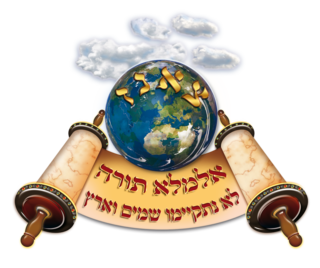
Klausenburg, also known as Sanz-Klausenburg, is a Hasidic dynasty that originated in the Transylvanian city of Cluj-Napoca, today in Romania.

Ohel is a structure built around a Jewish grave as a sign of prominence of the deceased. Ohelim cover the graves of some Hasidic Rebbes, important rabbis, tzadikim, prominent Jewish community leaders, and biblical figures. Typically a small masonry building, an ohel may include room for visitors to pray, meditate, and light candles in honor of the deceased.

Har HaMenuchot is the largest cemetery in Jerusalem. The hilltop burial ground lies at the western edge of the city adjacent to the neighborhood of Givat Shaul, with commanding views of Mevaseret Zion to the north, Motza to the west, and Har Nof to the south. Opened in 1951 on 300 dunams of land, it has continually expanded into new sections on the northern and western slopes of the hill. As of 2008, the cemetery encompasses 580 dunams in which over 150,000 people are buried.

Avrohom Bornsztain, also spelled Avraham Borenstein or Bernstein, was a leading posek in late-nineteenth-century Europe and founder and first Rebbe of the Sochatchover Hasidic dynasty. He is known as the Avnei Nezer after the title of his posthumously published set of Torah responsa, which is widely acknowledged as a halakhic classic. His only son, Shmuel, author of Shem Mishmuel, succeeded him as Rebbe.
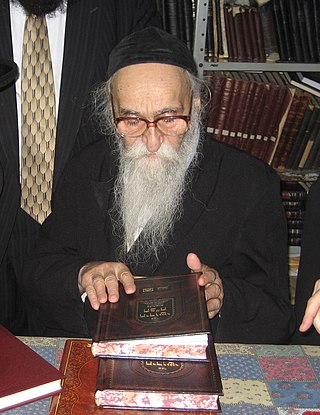
Meshulam Dovid Soloveitchik was a Haredi rabbi and rosh yeshiva of one of the branches of the Brisk yeshivas in Jerusalem.

Abraham Gershon of Kitov, also known as Rabbi Gershon of Brody, was probably born in or near Kuty (Kitov), Poland around 1701 and died in Jerusalem in 1761. He is best known as the Baal Shem Tov's brother-in-law.

Dov Schwartzman, also called Berel Schwartzman, was a Russian-born American Haredi Jewish rabbi, educator, Talmudic scholar, and rosh yeshiva (dean) of Bais Hatalmud, which he founded in the Sanhedria Murhevet neighborhood of Jerusalem and led for over 40 years. He also founded and led the Talmudical Yeshiva of Philadelphia together with Rabbi Shmuel Kamenetzky, and co-founded the first yeshiva in Israel for baalei teshuva. He taught tens of thousands of students, many of whom received semicha from him.
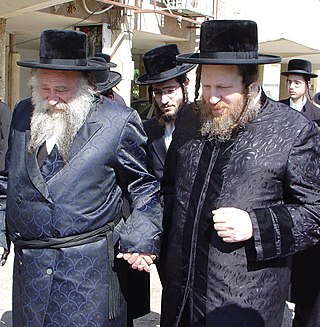
Mordechai Yissachar Ber Leifer was the third Rebbe of the Pittsburgh Hasidic dynasty. Born in the United States, he joined his father, Grand Rabbi Avraham Abba Leifer, in Ashdod, Israel, to serve as rosh yeshiva of a new Pittsburgher yeshiva in that city in 1981. After succeeding his father as Rebbe, he expanded the Hasidic presence in Ashdod with new schools and institutions, and increased the number of Pittsburgher families to nearly 200 in Ashdod. He also shepherded Pittsburgher Hasidim in Jerusalem, Bnei Brak, Beit Hilkia, New York City, and California. An accomplished Torah scholar and musical composer, he led the Hasidut for three decades until his death in 2020.

Shmuel Ehrenfeld, known as the Mattersdorfer Rav, was a pre-eminent Orthodox Jewish rabbi in pre-war Austria and a respected Torah leader and community builder in post-war America. He established Yeshivas Ch'san Sofer in New York City and taught thousands of students who went on to become leaders of American Torah Jewry. He also founded the neighborhood of Kiryat Mattersdorf in Jerusalem, where his son and grandson became prominent Torah educators. He was the great-great-grandson of the Chasam Sofer through the Chasam Sofer's daughter Hindel, who married Rabbi Dovid Tzvi Ehrenfeld.

Sanhedria Cemetery is a 27-dunam (6.67-acre) Jewish burial ground in the Sanhedria neighborhood of Jerusalem, adjacent to the intersection of Levi Eshkol Boulevard, Shmuel HaNavi Street, and Bar-Ilan Street. Unlike the Mount of Olives and Har HaMenuchot cemeteries that are located on the outer edges of the city, Sanhedria Cemetery is situated in the heart of western Jerusalem, in proximity to residential housing. It is operated under the jurisdiction of the Kehilat Yerushalayim chevra kadisha and accepts Jews from all religious communities. As of the 2000s, the cemetery is nearly filled to capacity.
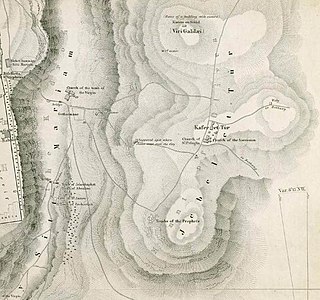
The Jewish Cemetery on the Mount of Olives is the oldest and most important Jewish cemetery in Jerusalem. It is approximately five centuries old, having been first leased from the Jerusalem Islamic Waqf in the sixteenth century. The cemetery contains anywhere between 70,000 and 150,000 tombs, including the tombs of famous figures in early modern Jewish history. It is considered to be the largest and holiest Jewish cemetery on earth.
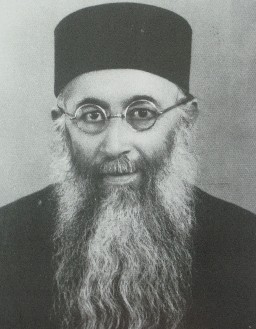
Yaakov Hai Zion Ades, also spelled Adas or Adess, was a Sephardi Hakham, Rosh Yeshiva, and Rabbinical High Court judge. As rosh yeshiva of Porat Yosef Yeshiva in Jerusalem, he raised thousands of students, including Rabbi Ovadia Yosef, Sephardic Chief Rabbi of Israel; Rabbi Ben Zion Abba Shaul, rosh yeshiva of Porat Yosef; and Rabbi Yehuda Hakohen Rabin, Chief Rabbi of Bukharan Jewry in Israel.

Chayey Moharan Hebrew: חיי מוהר"ן) is the biography of Rabbi Nachman of Breslov, written by his disciple and scribe Rabbi Nathan of Breslov. As the tzaddik is of central importance in Judaism and especially Breslov, and as the book is about Rabbi Nachman's life and Rabbi Nachman and his followers held himself to be the tzaddik hador, Chayey Moharan is an extremely important Jewish book. It became more widely known to Anglophones with the publication of its translation, titled Tzaddik, by Breslov Research Institute, in 1987. MOHaRaN is acrostic for Moreinu V'Rabeinu Harav Rabbi Nachman meaning "Our Master and Teacher, Rabbi Nachman."
Israel ben Eliezer, known as the Baal Shem Tov or as the Besht, was a Jewish mystic and healer who is regarded as the founder of Hasidic Judaism. "Besht" is the acronym for Baal Shem Tov, which means "Master of the Good Name," a term for a magician who wields the secret name of God.
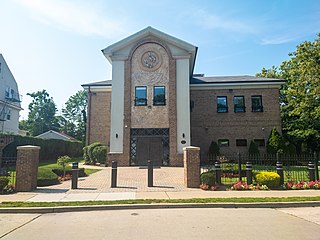
Congregation Aish Kodesh is an Orthodox synagogue in Woodmere, New York. Led since its founding in 1992 by Rabbi Moshe Weinberger, the synagogue was named after the Piaseczna Rav, Rabbi Kalonymus Kalman Shapira, known by the name of his last work, Aish Kodesh, who was a leading Polish Hasidic rabbi in prewar Europe. By injecting Hasidic elements into the prayer services, social events, and daily classes, Aish Kodesh has been called a "phenomenon" and a "revolution" in the religious community of Long Island.
Givat Moshe, also known as Gush Shemonim, is a Haredi Jewish neighborhood in Jerusalem bordering on Sanhedria, Mahanayim, Ezrat Torah, Shikun Chabad, and Tel Arza.
References
- 1 2 3 4 Stern, Shlomo (2010-05-18). "Preserving Mezhibuz's History: An interview with Rabbi Yisrael Meir Gabay, the longtime askan who is involved in restoring kivrei tzaddikim". Hamodia Magazine. Retrieved 2010-06-04.
- ↑ Database of Israeli citizens
- ↑ Toleikis, Vytautas (2008-11-27). "Repress, reassess, remember". Eurozine . Retrieved 2010-06-04.
- ↑ "Renovation of Gravestones in Eastern Europe". Dei'ah VeDibur. 2001-03-07. Retrieved 2010-06-04.
- ↑ Stern, Shlomo. Preserving Mezhibuz's History: An interview with Rabbi Yisrael Meir Gabay, the longtime askan who is involved in restoring kivrei tzaddikim (full article). Hamodia Magazine, 18 May 2010, p. 13.
- ↑ "Our Approach". otzadikim.com. Retrieved 2010-06-04.
- ↑ Friedman, Yisroel (2004-01-07). "A Man with a Grave Mission (Part I)". Dei'ah VeDibur. Archived from the original on 2009-12-30. Retrieved 2010-06-04.
- ↑ Steeble, Susan K. (2010). "Part 3: Deaths and Gravesites of the Two Tzaddiks". twotzaddiks.org. Retrieved 2010-06-04.
- ↑ Growise, Avraham. Our Man in Damascus: Rabbi Yisrael Meir Gabbai is the first non-Syria chareidi to visit in half a century, according to the leader of Syria's dwindling Jewish community. Hamodia, Israel News, 7 May 2008, pp. A26–27.